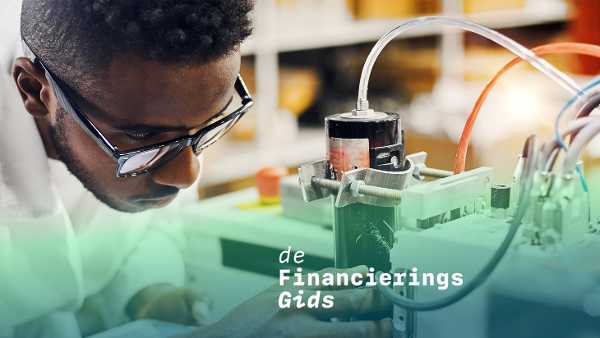The advantages of registering your trademark

- Sergej Schuurman
- The basis
- 12 December 2024
- Edited 7 January 2025
- 5 min
- Rules and laws
When you have developed a great product, you want to protect it. You can do this by registering your trademark. This puts you in a stronger position in case of abuse.
New laws and rules 2026
Make sure you know what's coming.
You see trademarks all around you. On the street, on the internet, and television. Legally speaking, a trademark is a collection of signs, symbols, colours, or sounds that distinguish a product or service.
But as a brand, you also want to express something. Think strength, experience, or service, for example. That is the marketing aspect of your trademark, it ensures your brand is distinctive and recognisable.
Types of brands
You can design a brand in different ways. The best known are wordmarks and pictorial marks. Consider the Dutch coffee brand Douwe Egberts. Douwe Egberts is the wordmark. The logo with the red shield and the abbreviation DE is the pictorial mark. A trademark often consists of a word and an image. But there are more features you can register as a trademark:
- Shape mark: A shape of a product or its packaging. For example, the shape of a Coca-Cola bottle.
- Colour mark: A colour or a combination of colours. For example, the colour green of the Dutch telecom company KPN.
- Sound mark: For example, the advertising tune of Dutch electronics retailer Coolblue.
Protecting your trademark
Developing your product or service costs time and money. This makes your trademark worth money. You protect that value with trademark registration. Trademark registration gives you exclusive rights to your brand. This makes your trademark worth more money. Registration also comes across as professional and strengthens your competitive position.
Trademark registration acts as a deterrent against abuse. If a person or company misuses your trademark, registration will make it easier to act against this.
Checking before registration
For the Netherlands, Belgium, and Luxembourg, you protect your trademark at the Benelux Office for Intellectual (BOIP). You can hire a specialist or apply for registration yourself. You should first check if the trademark already exists.
You may not register a trademark that already exists. You also cannot register a business name that is already being used by another company as a trademark. A business name or trade name is for distinguishing your company. A trademark or brand name is for distinguishing your product or service.
To check this, you can use the KVK Name Check tool. With this, you search the BOIP Trademarks Register and the KVK Business Register. Also search the internet to check whether the name or trademark already exists.
Your trademark should be distinctive. For example, the mark should not be simply a description. Calling the bicycles you make ‘Bicycle’ is not allowed but ‘Locomotive’, for example, is allowed as a brand name for bicycles.
The mark cannot be misleading either. If, for example, you make hamburgers from meat, you are not allowed to register Vege-burger as a trademark for them.
Classes of registration
At BOIP, you indicate in which class you want to register your trademark. There are 45 classes. Classes 1 to 34 are for products and classes 35 to 45 for services. Your product or service must fit within one of those classes.
You can also apply for registration for several classes. This is useful, for instance, if you want to use your trademark for several products or services in the future. You cannot add a class to your trademark afterwards. You will then have to pay to re-register your trademark.
Your mark must appear clearly and accurately in the trademark register. That is, audibly or visibly. Registering your trademark can be done with a photo, animation file, sound file, or text. The process from application to registration at BOIP takes about 3 months.
Think carefully before applying for trademark registration. If BOIP refuses your trademark registration because it is not distinctive or misleading, you will lose your application fee.
Protecting a trademark outside the Benelux
When you register a trademark with BOIP, you do so for the Benelux. You will then have trademark protection in the Netherlands, Belgium, and Luxembourg. If you only do business within this area, this registration is enough.
If you do business outside the Benelux, it is a good idea to register your trademark there as well. EU trademark applies to all 27 countries in the European Union. This does involve a risk.
Your trademark will be assessed on whether it is sufficiently distinctive for all 27 countries. If that is not the case in just 1 country, the registration will be refused in its entirety, and you will lose your application fee. You can apply for EU trademark registration at the European Union Intellectual Property (EUIPO).
If you have a Benelux or EU trademark and you also do business outside the European Union, you can apply for international registration. This registration applies to more than 110 .
You submit your application to BOIP, specifying the countries for which you want to register your trademark. BOIP will check the application and send it to the World Intellectual Property (WIPO). This is the body that manages the international trademark register.
You can also file a trademark registration yourself for each country. But that takes more time, effort, and money. Also, the rules are different for each country.
Maintaining your trademark
Just registering a trademark is not enough. It may expire if you cannot prove that you have actively used your trademark for 5 years. You will then lose your registration. To prove that you are using your trademark you can use invoices, advertising brochures, or screenshots of your website where your trademark is clearly visible.
Also be careful when changing your logo. Then your existing trademark registration may no longer offer the right protection. A trademark specialist can inform you about this.
Your trademark is protected in the Benelux for 10 years from the date of application. After that, you can renew the trademark as many times as you like. Renewal is possible from 6 months before the expiry date until 6 months after the expiry date of the trademark registration.
Infringement of your trademark
Infringement occurs if, for example, a name or logo is the same or similar to your registered trademark. Also, that name or logo must have been used for roughly the same products or services.
There are also other forms of infringement. For example, the use of the logo or name must not be detrimental to your brand, damage its reputation, or create false associations.
In case of infringement, try to reach an out-of-court settlement with the party responsible. Make a mutual financial settlement or ensure that they remove the products, name, or logo from the market.
If this fails, you can go to court. The court can, for instance, forbid the use of your name or logo, award damages, impose a penalty, or have goods seized. In case of infringement, always call in a specialist.
Costs for trademark registration
There are costs for all types of trademark registration. A Benelux trademark registration has application fees from , for 10 years. You pay €27 for a second class and another €81 for each additional class. Renewing the Benelux registration costs €263.
An EU trademark is more . You pay €850 for one class. A second class is €50 and every other class more €150. For an international trademark registration, you pay BOIP €84 for forwarding your application to WIPO. There is then an additional fee for the basic registration at WIPO and the cost of trademark registration per . These can vary considerably. You can use the WIPO fee to find out the costs.

